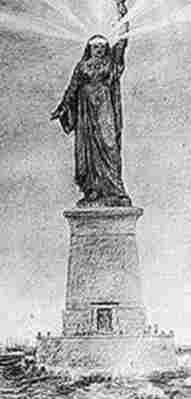President Trump added more controversy to the early days of his administration by signing an executive order temporarily suspending entry of all refugees to the U.S., barring Syrian refugees indefinitely, and blocking entry for citizens of seven predominantly Muslim countries for 90 days. Since the late-January order, thousands of Americans have taken to the streets and international terminals of airports to protest what they deem to be a dangerous, un-American act. More than a few have evoked the words written on the Statue of Liberty as a strong argument for why our country should admit those who seek safety, opportunity, or both. What many do not realize about the statue, however, is that it was originally modeled on a Muslim woman.
The creator of the world's most famous statue was the French-born sculptor Frédéric-Auguste Bartholdi. Before designing Lady Liberty , Bartholdi traveled extensively through Egypt, taking much inspiration from the colossal Nubian figures at Abu Simbel. As construction of the 120-mile-long Suez Canal neared completion in 1869, the Egyptian government considered erecting a lighthouse at the entrance to the waterway. Instead, Bartholdi submitted a design for an 86-foot-tall woman dressed in traditional Arab garb; he called her "Egypt Carrying the Light to Asia."

The sketch of Bartholdi's proposal for the Suez Canal shows a Muslim woman wearing traditional Arab clothing.
According to the book The Statue of Liberty: A Transatlantic Story (Yale University Press, 2012), by New York University history professor Edward Berenson, the Egyptians rejected Bartholdi's design, opting for a more cost-effective proposal. If the sculptor was disappointed, he didn't show it, as he quickly turned his attention to a bold new project in his native country—a gift from the French to celebrate the centennial of the American Declaration of Independence. By 1886, Bartholdi's Egyptian proposal was slightly altered to become Lady Liberty—the statue many Americans have looked to for over a century as a beacon of tolerance and freedom.